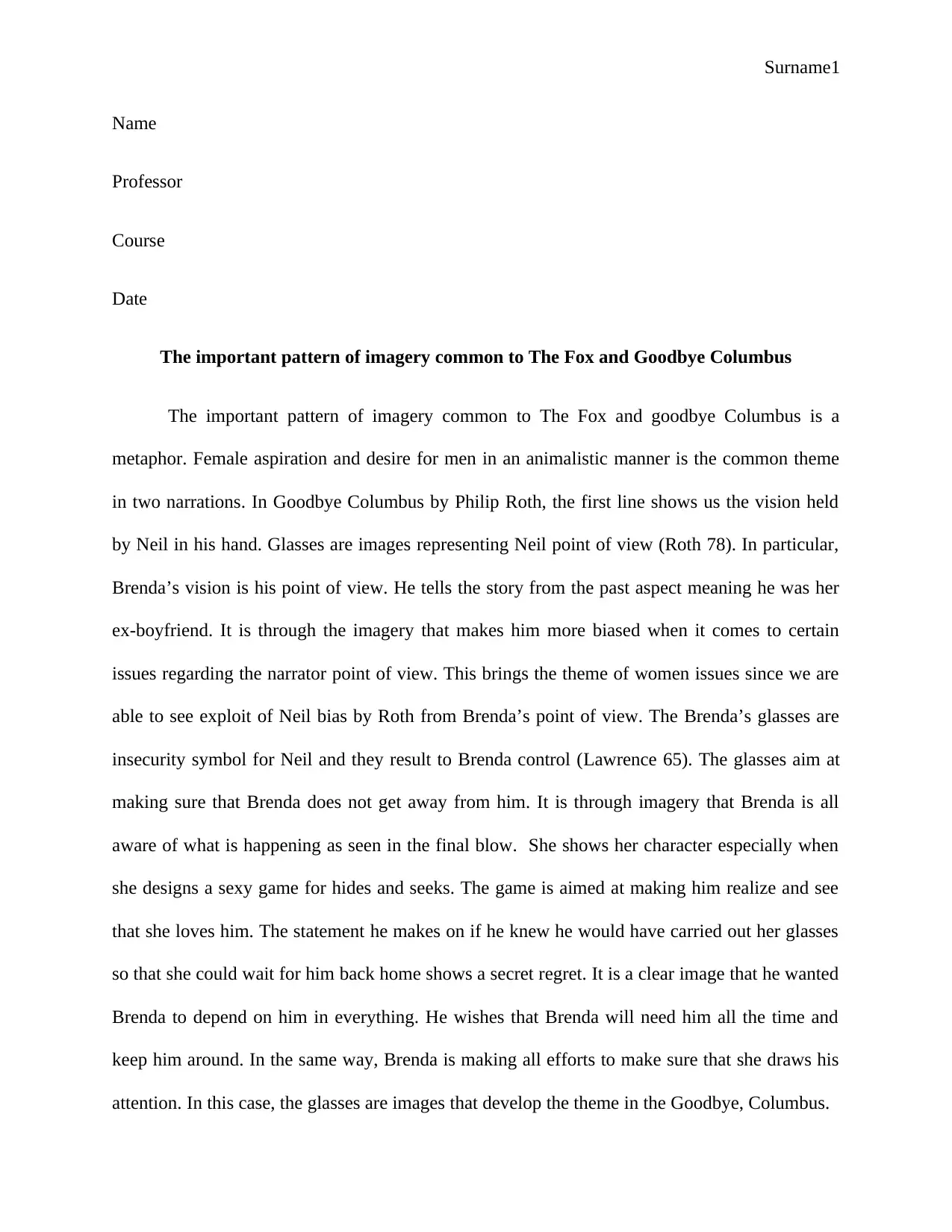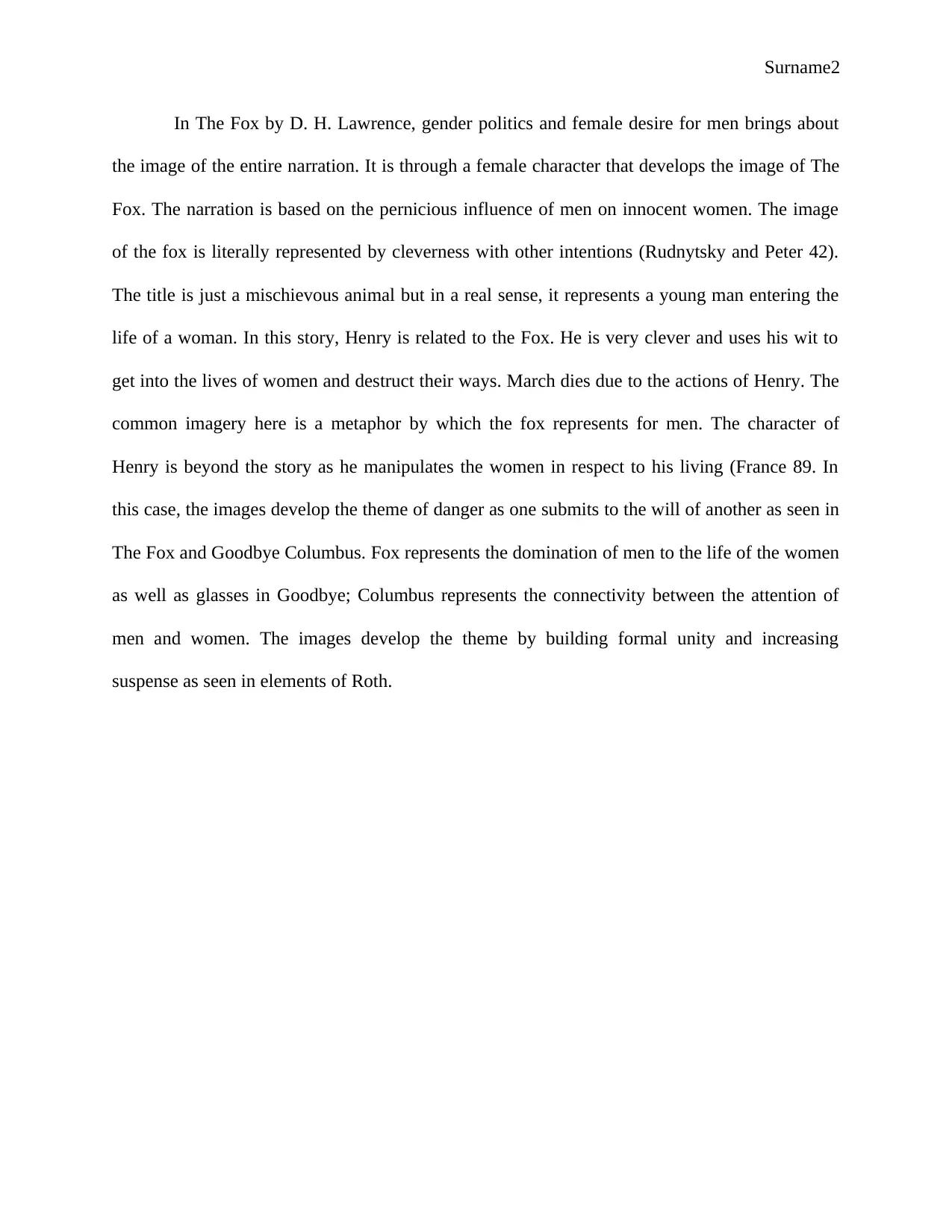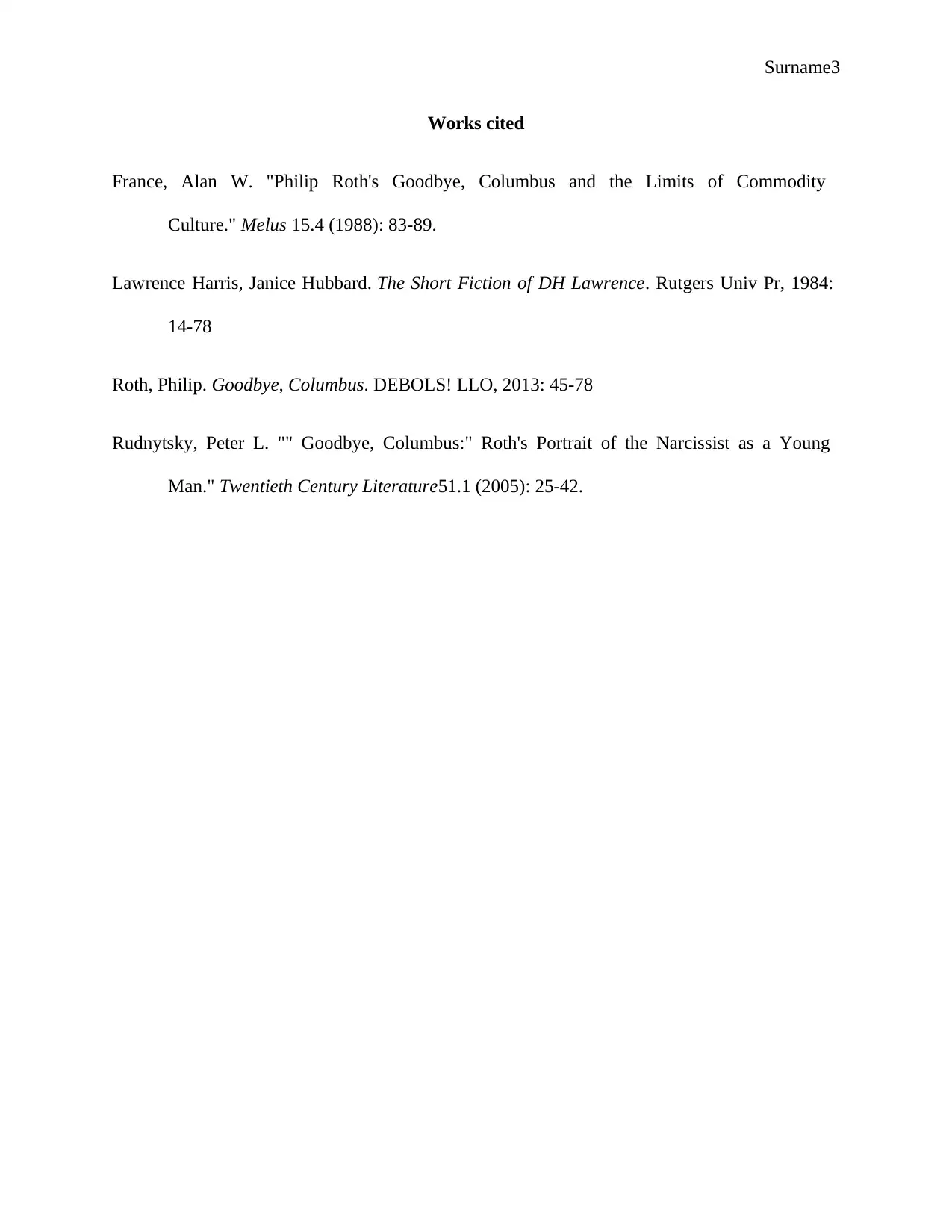A Comparative Essay on Imagery in The Fox and Goodbye, Columbus
VerifiedAdded on 2023/06/10
|3
|696
|399
Essay
AI Summary
This essay provides a comparative analysis of the imagery employed in D.H. Lawrence's "The Fox" and Philip Roth's "Goodbye, Columbus." The essay focuses on the common thread of imagery, particularly the use of metaphors, to explore themes of gender dynamics, female desire, and the po...

Surname1
Name
Professor
Course
Date
The important pattern of imagery common to The Fox and Goodbye Columbus
The important pattern of imagery common to The Fox and goodbye Columbus is a
metaphor. Female aspiration and desire for men in an animalistic manner is the common theme
in two narrations. In Goodbye Columbus by Philip Roth, the first line shows us the vision held
by Neil in his hand. Glasses are images representing Neil point of view (Roth 78). In particular,
Brenda’s vision is his point of view. He tells the story from the past aspect meaning he was her
ex-boyfriend. It is through the imagery that makes him more biased when it comes to certain
issues regarding the narrator point of view. This brings the theme of women issues since we are
able to see exploit of Neil bias by Roth from Brenda’s point of view. The Brenda’s glasses are
insecurity symbol for Neil and they result to Brenda control (Lawrence 65). The glasses aim at
making sure that Brenda does not get away from him. It is through imagery that Brenda is all
aware of what is happening as seen in the final blow. She shows her character especially when
she designs a sexy game for hides and seeks. The game is aimed at making him realize and see
that she loves him. The statement he makes on if he knew he would have carried out her glasses
so that she could wait for him back home shows a secret regret. It is a clear image that he wanted
Brenda to depend on him in everything. He wishes that Brenda will need him all the time and
keep him around. In the same way, Brenda is making all efforts to make sure that she draws his
attention. In this case, the glasses are images that develop the theme in the Goodbye, Columbus.
Name
Professor
Course
Date
The important pattern of imagery common to The Fox and Goodbye Columbus
The important pattern of imagery common to The Fox and goodbye Columbus is a
metaphor. Female aspiration and desire for men in an animalistic manner is the common theme
in two narrations. In Goodbye Columbus by Philip Roth, the first line shows us the vision held
by Neil in his hand. Glasses are images representing Neil point of view (Roth 78). In particular,
Brenda’s vision is his point of view. He tells the story from the past aspect meaning he was her
ex-boyfriend. It is through the imagery that makes him more biased when it comes to certain
issues regarding the narrator point of view. This brings the theme of women issues since we are
able to see exploit of Neil bias by Roth from Brenda’s point of view. The Brenda’s glasses are
insecurity symbol for Neil and they result to Brenda control (Lawrence 65). The glasses aim at
making sure that Brenda does not get away from him. It is through imagery that Brenda is all
aware of what is happening as seen in the final blow. She shows her character especially when
she designs a sexy game for hides and seeks. The game is aimed at making him realize and see
that she loves him. The statement he makes on if he knew he would have carried out her glasses
so that she could wait for him back home shows a secret regret. It is a clear image that he wanted
Brenda to depend on him in everything. He wishes that Brenda will need him all the time and
keep him around. In the same way, Brenda is making all efforts to make sure that she draws his
attention. In this case, the glasses are images that develop the theme in the Goodbye, Columbus.
Secure Best Marks with AI Grader
Need help grading? Try our AI Grader for instant feedback on your assignments.

Surname2
In The Fox by D. H. Lawrence, gender politics and female desire for men brings about
the image of the entire narration. It is through a female character that develops the image of The
Fox. The narration is based on the pernicious influence of men on innocent women. The image
of the fox is literally represented by cleverness with other intentions (Rudnytsky and Peter 42).
The title is just a mischievous animal but in a real sense, it represents a young man entering the
life of a woman. In this story, Henry is related to the Fox. He is very clever and uses his wit to
get into the lives of women and destruct their ways. March dies due to the actions of Henry. The
common imagery here is a metaphor by which the fox represents for men. The character of
Henry is beyond the story as he manipulates the women in respect to his living (France 89. In
this case, the images develop the theme of danger as one submits to the will of another as seen in
The Fox and Goodbye Columbus. Fox represents the domination of men to the life of the women
as well as glasses in Goodbye; Columbus represents the connectivity between the attention of
men and women. The images develop the theme by building formal unity and increasing
suspense as seen in elements of Roth.
In The Fox by D. H. Lawrence, gender politics and female desire for men brings about
the image of the entire narration. It is through a female character that develops the image of The
Fox. The narration is based on the pernicious influence of men on innocent women. The image
of the fox is literally represented by cleverness with other intentions (Rudnytsky and Peter 42).
The title is just a mischievous animal but in a real sense, it represents a young man entering the
life of a woman. In this story, Henry is related to the Fox. He is very clever and uses his wit to
get into the lives of women and destruct their ways. March dies due to the actions of Henry. The
common imagery here is a metaphor by which the fox represents for men. The character of
Henry is beyond the story as he manipulates the women in respect to his living (France 89. In
this case, the images develop the theme of danger as one submits to the will of another as seen in
The Fox and Goodbye Columbus. Fox represents the domination of men to the life of the women
as well as glasses in Goodbye; Columbus represents the connectivity between the attention of
men and women. The images develop the theme by building formal unity and increasing
suspense as seen in elements of Roth.

Surname3
Works cited
France, Alan W. "Philip Roth's Goodbye, Columbus and the Limits of Commodity
Culture." Melus 15.4 (1988): 83-89.
Lawrence Harris, Janice Hubbard. The Short Fiction of DH Lawrence. Rutgers Univ Pr, 1984:
14-78
Roth, Philip. Goodbye, Columbus. DEBOLS! LLO, 2013: 45-78
Rudnytsky, Peter L. "" Goodbye, Columbus:" Roth's Portrait of the Narcissist as a Young
Man." Twentieth Century Literature51.1 (2005): 25-42.
Works cited
France, Alan W. "Philip Roth's Goodbye, Columbus and the Limits of Commodity
Culture." Melus 15.4 (1988): 83-89.
Lawrence Harris, Janice Hubbard. The Short Fiction of DH Lawrence. Rutgers Univ Pr, 1984:
14-78
Roth, Philip. Goodbye, Columbus. DEBOLS! LLO, 2013: 45-78
Rudnytsky, Peter L. "" Goodbye, Columbus:" Roth's Portrait of the Narcissist as a Young
Man." Twentieth Century Literature51.1 (2005): 25-42.
1 out of 3
Your All-in-One AI-Powered Toolkit for Academic Success.
+13062052269
info@desklib.com
Available 24*7 on WhatsApp / Email
![[object Object]](/_next/static/media/star-bottom.7253800d.svg)
Unlock your academic potential
© 2024 | Zucol Services PVT LTD | All rights reserved.